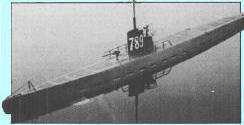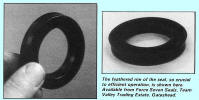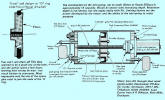|
U789
Part 5 - Kapitan Bill Thomas
|
|
 |
|
Trying your patients.
The ability to modestly disappear
from public gaze is a most valuable and treasured asset to all submariners
British submarines based in Malta in 1942, when the island was being
heavily and frequently bombed, would discretely lower themselves on to the
harbour bed until the raiders went home. Model submariners also can avoid
lesser but nevertheless irritating visitors, by submerging and lying low.
Typical of these is the Greater Silly Question Asker (GSQA). Fortunately,
you mostly hear them before you see them, and you have plenty of time to
flood your tanks and take to the lake bed before they arrive at your
elbow, by which time you pretend you are sailing some other model,
preferably a fairly nondescript one, so as not to stimulate their limited
conversational powers. Until such time as you develop the required
experience and skills of the expert model submarine commander, such as my
good self, you are likely to become involved in the following type of
question and answer routine, of which you will soon tire :-
|
G.S.Q.A. (Great Silly Question Asker ) "Is it a submarine Mister?" (
The water is crystal clear, the boat is 8 feet away and about 1 foot under
the surface. props, rudder, planes, tower, guns etc. all clearly visible).
L.S.M.S. (Long suffering Model Submariner) Well, sort of.....
G.S.0.A. What do you mean sort of?
L.S.M.S. It's an underwater Airship .
G,S.Q.A.: looks like a submarine",
L.S.M.S.: Only because its tanks are full of water instead of gas .
G.S.Q.A.: 0h. Does the water get in those slots?".
L.S.M.S.: "Yes".
G.S.0.A.: Why doesn't it fill the underwater airship and sink it?".
L.S M. S.: Underwater airships have holes drilled in the bottom so
that any water which gains egress may consequently drain out again .
G. S. Q. A, That's right. They must be a new idea, I've never seen
one on the telly".
L S. M. S.: They'll probably never get off the ground"
( L.S.M.S. then cracks up when the G.S.Q.A. inquires if the
underwater airship is remote controlled, and hits him with his six channel
transmitter. |
|
SSC Tactics!
The above exchange exposes the submarine commander in question for what he
is a novice. His big mistake was to allow himself to be caught on the
surface at close quarters by the G.S.Q.A. He followed this up by
attempting to match lunatic questions with lunatic answers. Fatal! Never
fight an opponent on his chosen ground. If you find yourself in a hole,
stop digging. Use monosyllabic grunts and nods for answers. The superior
submarine commander, however, uses his superior judgement and awareness to
avoid having to use his superior skill. He would never have allowed the
encounter to take place. He would have spotted the G.S.Q.A. first and
flooded his main tanks, reducing his silhouette to a low grey line on the
water. He would then flick a second switch on his transmitter. Deep within
the heart of the submarine, an additional pump, the trim pump, would admit
a few extra cc's of water. Silently and discretely, the boat would
disappear from view and lie doggo on the bottom till the dancer was past.
No sweat, no hassle.
Surface when the prat
has passed.
It is the secret of this vital pump, the trim pump, that I am about to
reveal to your delighted gaze. Read on, but be warned that you must on no
account discuss these matters in public, since technology of staggering
technical brilliance is involved which could be of incalculable value to a
potential enemy. I really mean that most sincerely.
|
|
The Pump
Such pumps are available commercially, and have been advertised in the
modelling press. I have heard good reports on their performance. Their
disadvantages, well, they are not cheap, and they appear to be
unnecessarily large for the purposes that I had in mind. The unit have
designed, constructed, and have operated for the past several months
avoids these factors.
|
|
The Cylinder
I tend to think of metal when
looking for solutions to problems, be they modelling, household, car, etc.
So I thought straight away of copper, brass, or stainless steel for the
cylinder. None of them were easily obtainable in the sizes I had in mind.
I wanted to be to pump about half a pint of water in or out of the model a
cylinder of about 60mm diameter by about 150mm length to be on the safe
side. Then there was the weight factor. Many people have the idea that
weight is unimportant in a submarine, which is quite wrong. You do need
weight, but in the proper place, right down in the keel. Top weight really
is a dead loss, and lightness, consistent with sound construction, is the
order of the day.
In my searches, I came across a piece of plastic drainpipe, or to be more
exact, rainwater downpipe, a grey material, PVC (ABS?), of exactly the
diameter I was seeking. At first, I dismissed it out of hand. it did not
looks as if it would bond well with the other materials I had in mind.
Later, I had second thoughts as it was very light, it was very cheap, it
would not corrode, the surface finish and bore were very accurate and
smooth. I decided to settle for it, and it has proved a superb material
for the job.
|
|

|
|
The Piston
The piston and its seal are crucial
elements in the functioning of the unit. With too tight a fit, excessive
effort will be required from the motor and battery, whereas too easy a fit
will result in disastrous leakages. I made the piston from nylon, turned
to size and shape on a lathe. The fit between the brass leadscrew and the
nylon piston took a little getting right, but so far it had done its job
well and has not leaked a drop. The seal, however, caused problems which
at one stage appeared insuperable, and because benefit can be derived from
the study of failures, I will briefly outline my unsuccessful efforts.
I
originally envisaged a type of piston using an "0" ring seal. Turning the
piston from nylon was no problem, but the "0" ring most certainly was. I
obtained a Hoover drive belt, 1/4in circular in cross section, of a tough
rubbery plastic, which was well oversize in length. I cut it with a
scalpel and joined the ends with cyano‑acrylate glue (Superglue). I
had to repeat this process several times, gradually shortening it till I
got a fit anywhere near what I regarded as being practical, eventually I
was paring a few thou's off at a time. However it was no use. The required
smoothness of the piston in the bore could not be obtained. In passing,
however, I must mention the strength of the joints formed by the cyano it
was fantastic. Even I, with my colossal physical power was unable to pull
the joints apart,
So I looked around and made enquiries, which led me to Force Seven Seals
Ltd., Team Valley Trading Estate, Gateshead, Tyne and Wear. I took with me
a piece of plastic drainpipe and described the nature of the problem to
them. They were very helpful. They came up instantly with a seal for about
£1.50 (this was in 1984) which worked perfectly from the word 'go'. Note
the 'feathered' cross sectional shape of the edge. This shape will resist
great pressures from one direction, little pressure from the opposite
direction. This is an added bonus, since if excessive air pressure builds
up inside the submarine, the seal acts like a safety valve by allowing air
to escape. The seal reference is GACO UM6040. |
|

|
|
The Motor
The motor/gearbox unit I used to
operate the pump is a very neat job, and has proved ideal, obtainable from
R.S. Components at £11 (1984). It is available in either 6 or 12 volt
versions, 330 or 660 rpm. Compact and robust. I chose the 6 volt 330 rpm
version Catalogue No 336/343. Built into it is a useful 4 hole flange
which enables you to bolt it neatly on to the end disc of the cylinder.
I used 1/4in. thick Perspex sheet for the ends of the cylinder. The end to
which the motor is attached is removable for inspection of the innards; 3
x 6BA set screws hold it in position. The other end, however is a
permanent fixture, bonded with Super glue with set screws for additional
insurance as a failure here would sink the boat. Leakage at the water end
of the cylinder is prevented by an 0 ring.
To prevent the piston hitting the ends of the cylinder, plungers are
fitted which operate micro switches when the piston reaches the desired
end of its travel. I made a leaf spring from a piece of hacksaw
blade to keep the plunger pressed firmly in the closed position. This is
one of the limiting factors regarding the depth at which the pump can
operate. If the water pressure increased inside the cylinder to such an
extent that the strength of the spring was overcome, leakage would occur.
This however has not come to pass so far.
The pump can be operated according to the number of channels at the user's
disposal. Personally I use
what used to be the retract switch on my 6 channel transmitter. This is a
two position switch which puts the servo output arm fully to one side or
the other of its travel it cannot be stopped at any intermediate position.
This means that the pump would either be completely full of water or
completely empty. I wanted to control the amount of water I took on board
a little better than that, so a three position switch was fitted by Model
Avionics (it's Futaba gear), which enables the piston to be stopped at any
point on its travel. I can take on or expel very small quantities of water
which is very handy in balancing the boat.
I have mentioned that although only a few cc's of water is enough to
change the buoyancy of a trimmed down submarine from positive to negative
and vice versa, The cylinder that I opted for has a swept volume of about
350cc. There is a reason for this. When I balanced the boat ( trimmed down
to decks awash), I did so with the trim pump half full of water. (This is
with the main tanks full, and very small lead weights added where
necessary to leave the boat just barely afloat). As mentioned, a few cc's
of water taken in sends her down, but if some emergency develops, I can
also pump out the extra 160cc's that I started with to gain a little extra
buoyancy.
|
|

|
|
Fail Safe
Between the servo which operates the pump and the pump itself is one of
Graham Drury's Fail Safe Units, which in the event of a radio failure is
arranged to switch on the pump and blow the water out. So far, a real
radio failure has not occurred in U812, but when I deliberately switch off
my transmitter with the boat lying on the lakebed, the system has worked,
bringing the boat reliably to the surface. I have an identical Fail Safe
Unit in the main motor switching circuit, which will stop the motors in an
emergency, so that if a fault occurs with the planes set to dive, the boat
will not propel itself deeper and deeper to its own destruction. Radio
modellers of all types can save much time, temper and expense. I wish I
had come across them earlier in my modelling career, especially during the
powerboat era, when I watched many a good boat hurtle to self destruction
at full bore instead of shutting off the power and waiting to be rescued.
|
|
 |
|
To the Tools
The first "serious" model I ever attempted was of the light cruiser HMS
Ajax, 69in. long, of metal construction, and I built it on the floor of
the living room over a period of two years; I mention this because I can
understand the feelings of readers who on looking at this article will see
that it is frankly a model engineering job, and requires the use of a
lathe. I know how galling it can be to read about projects which involve
the use of equipment which is impractical through circumstances to own,
being an ex member of the kitchen table brigade, which incidentally
includes some of the most ingenious and resourceful practitioners in the
game.
Finally, however, I tired of endless improvisation, and took the plunge. A
bank loan bought me a brand new Myford ML10 0, and left me almost skint
for two years, but I never regretted it. If you buy a new car, you lose a
vast amount of money the minute you drive it out of the showroom (they
tell me), but in contrast, lathes, like houses, just keep on increasing in
value try buying a good second hand one! Properly used, a lathe will last
a century; it is an investment, well worth thinking about if you are
deeply into your hobby. Regarding the actual making of the component parts
of the pump, I am not going into detail, as the unit is a very
straightforward exercise in fitting and turning, with no hidden bugs. Do
not treat it as a rush job, however, careful workmanship is needed as in
all parts of a submarine, which is more prone to disaster than most
waterborne craft.
|
|
In Depth
A much asked question (and a sensible one, which like all sensible
questions, should be answered sensibly) is: "How deep will the model
dive?" Well, Tynemouth lake, where the submarine sails most of the
time, is only about 3 feet deep, which has caused no difficulties. Perhaps
when we talk about 4 or 5 feet dives we could be talking in terms of
nervous breakdowns. What would fail first? The ability of the
receiver to pick up signals? Very possible. The crush depth of the hull
being exceeded? Unlikely with a well made hull. The lack of sufficient
power in the trim Pump to expel water under the increased pressure?
Frankly, not known at this stage. An internal Plumbing failure due to
excessive pressure? Well, I would have to say that in the case of my boat,
this would be the most likely cause. I have used silicone rubber tubing to
connect Pumps, pipes etc. It is funny stuff. At times, it seems to possess
quite unexpected toughness, and then again on other occasions, I have seen
it just split and surrender abjectly. However I'm inclined to trust it up
to a Point, provided it is not subjected to too much warmth and an oily
environment. It seems to be unaffected by water, which is the main thing,
but I check it quite frequently.
If you wanted to go really deep, I think all metal pipe work is necessary.
I have sailed the boat from time to time on Derwent water, but the water
is deep and cold, and I don't recommend it for persons of a nervous
disposition, (in which category I include my good self). The chances of a
successful salvage operation in really deep waters are remote, and add
significantly to what I call the laxative factor of large lake submarine
operations. Besides the natural hazards of nature and physics are added to
by sailing boats, motor boats, ferries and windsurfers (who travel at
speeds of 20 knots and have only the most marginal control over their
ridiculous craft), and of course there are the geese. I see why they are
referred to as "wild life". Believe you and me, U boats make them furious,
But I will not distress readers with tales of my sufferings on their
behalf, and anyway, I digress. In answer to the question How deep?", my
advice is to estimate how deep you would send it for a wager of £250, and
divide the answer by three!
|
|
Back to U 789 index
Home
|




